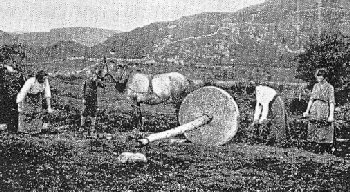I watched a youth last autumn single-handedly sweep – like Tornado Katrina’s landfall on the
This boy sat high up on a massive machine, the very latest in combine-harvesters, and he threw it about like a toy. I timed him at two minutes to clear a quarter-acre hay field. It would have been quicker but the field’s small dimensions clearly cramped his style.
‘Is he your lad?’ I casually enquired of the old fellow, leaning on his stick, as he emerged from a nearby cottage.
‘Ach, not at all!’ he answered.
‘Sure we don’t even know him!
He’s from up the country somewhere, and that’s where he’ll return in an hour’s time when the sun sets.
He did McCreesh’s farm before he come to me and he’s still to go over to Barney Fegan’s.
But he’ll get it all done and time to spare.
There’s quare changed times since my youth!’
There was a sadness too in his tone.
‘You’ve heard of the Calliagh Bhirra surely? She had her house – and a lake – up there on the top of Slieve Gullion! She was an oul’ hag of a woman but how she got into the cutting of the corn, nobody knows.
When the field was nearly bare the last straws were woven into three plaits and cut be the throwin’ of hooks, or be the sweep of the scythe. Then it would go to hang on the souple.
There’d be a dance that night! Indeed, there’d be dances in all the houses in harvest time, night about. But times are changed! Who’d let them in to dance now?’
A hundred years ago in harvest time in
The scythe was then the common cutting implement but I (i.e. Thomas Mallon!) remember – from the First War time – seeing the sickle in use for shearing wheat straw for the purpose of thatching.
(Editor: I mind my uncle Jamesy demonstrating the use of both implements to me in the late 50’s, him well knowing that their day had already passed).
More …..
